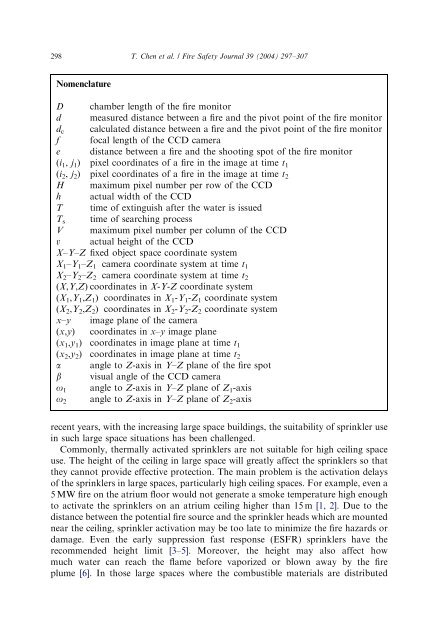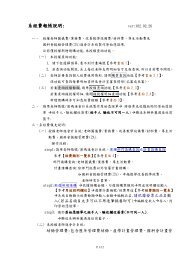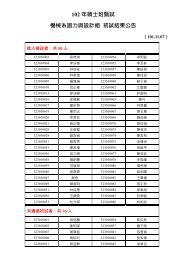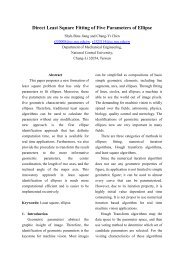An automatic fire searching and suppression system for large spaces
An automatic fire searching and suppression system for large spaces
An automatic fire searching and suppression system for large spaces
Create successful ePaper yourself
Turn your PDF publications into a flip-book with our unique Google optimized e-Paper software.
ARTICLE IN PRESS<br />
298<br />
T. Chen et al. / Fire Safety Journal 39 (2004) 297–307<br />
Nomenclature<br />
D chamber length of the <strong>fire</strong> monitor<br />
d measured distance between a <strong>fire</strong> <strong>and</strong> the pivot point of the <strong>fire</strong> monitor<br />
d c calculated distance between a <strong>fire</strong> <strong>and</strong> the pivot point of the <strong>fire</strong> monitor<br />
f focal length of the CCD camera<br />
e distance between a <strong>fire</strong> <strong>and</strong> the shooting spot of the <strong>fire</strong> monitor<br />
(i 1 , j 1 ) pixel coordinates of a <strong>fire</strong> in the image at time t 1<br />
(i 2 , j 2 ) pixel coordinates of a <strong>fire</strong> in the image at time t 2<br />
H maximum pixel number per row of the CCD<br />
h actual width of the CCD<br />
T time of extinguish after the water is issued<br />
T s time of <strong>searching</strong> process<br />
V maximum pixel number per column of the CCD<br />
v actual height of the CCD<br />
X–Y–Z fixed object space coordinate <strong>system</strong><br />
X 1 –Y 1 –Z 1 camera coordinate <strong>system</strong> at time t 1<br />
X 2 –Y 2 –Z 2 camera coordinate <strong>system</strong> at time t 2<br />
(X,Y,Z) coordinates in X-Y-Z coordinate <strong>system</strong><br />
(X 1 ,Y 1 ,Z 1 ) coordinates in X 1 -Y 1 -Z 1 coordinate <strong>system</strong><br />
(X 2 ,Y 2 ,Z 2 ) coordinates in X 2 -Y 2 -Z 2 coordinate <strong>system</strong><br />
x–y image plane of the camera<br />
(x,y) coordinates in x–y image plane<br />
(x 1 ,y 1 ) coordinates in image plane at time t 1<br />
(x 2 ,y 2 ) coordinates in image plane at time t 2<br />
a angle to Z-axis in Y–Z plane of the <strong>fire</strong> spot<br />
b visual angle of the CCD camera<br />
o 1 angle to Z-axis in Y–Z plane of Z 1 -axis<br />
angle to Z-axis in Y–Z plane of Z 2 -axis<br />
o 2<br />
recent years, with the increasing <strong>large</strong> space buildings, the suitability of sprinkler use<br />
in such <strong>large</strong> space situations has been challenged.<br />
Commonly, thermally activated sprinklers are not suitable <strong>for</strong> high ceiling space<br />
use. The height of the ceiling in <strong>large</strong> space will greatly affect the sprinklers so that<br />
they cannot provide effective protection. The main problem is the activation delays<br />
of the sprinklers in <strong>large</strong> <strong>spaces</strong>, particularly high ceiling <strong>spaces</strong>. For example, even a<br />
5 MW <strong>fire</strong> on the atrium floor would not generate a smoke temperature high enough<br />
to activate the sprinklers on an atrium ceiling higher than 15 m [1, 2]. Due to the<br />
distance between the potential <strong>fire</strong> source <strong>and</strong> the sprinkler heads which are mounted<br />
near the ceiling, sprinkler activation may be too late to minimize the <strong>fire</strong> hazards or<br />
damage. Even the early <strong>suppression</strong> fast response (ESFR) sprinklers have the<br />
recommended height limit [3–5]. Moreover, the height may also affect how<br />
much water can reach the flame be<strong>for</strong>e vaporized or blown away by the <strong>fire</strong><br />
plume [6]. In those <strong>large</strong> <strong>spaces</strong> where the combustible materials are distributed

















